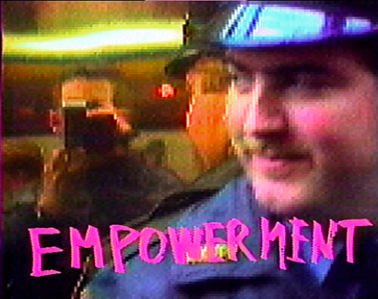
Robert Buck
Robert Buck, formerly Robert Beck, is most known for his paintings, drawings, sculptures, and installations, and for his precise use of materials, ranging from traditional art supplies to such non-art materials as mortician’s wax, latent fingerprint ink, and gunpowder. Yet the moving-image, in form and practice—especially the key filmic gesture of “the cut”—has profoundly influenced Buck’s career and self-representation. In 2008, Beck changed his father’s name by a single vowel as a work, or act, of art, highlighting a cut from Beck to Buck that is reiterated in EAI’s distribution of works under both signatures.
In an introductory text for Beck’s solo exhibition dust at the Wexner Center for the Arts in 2007, curator Bill Horrigan observed: “...It’s the moving image – cinema, video art, television – that haunts [Beck’s] drawings, photographs, even sculptures, partly through his insistence that any given piece derives its expressivity from the images he places alongside it (the theory of montage as an organizing principle: each single film frame requires every other one to mimic reality), and partly through how the exquisitely handcrafted stillness of his imagery discloses the artist’s imagination to be one that’s compelled to envision what he renders in time.”
Expanding beyond the cinematic trope of the montage, Buck’s approach to the cut considers the associative power of contingent images and events, and is understood to be as much an artistic, as psychological, process. This is made especially graphic in Nine Years Later (“Panic”) (1996-2001), one of a three-part series in which the artist revisits video performances that he staged nearly a decade earlier. A startling image of a razor blade in a pool of fake blood introduces a work that is reflexively focused on editing, the razor blade symbolizing a corporeal connection between splicing and cutting, and bodily violation. A dry recitation from a manual on analog video editing makes this explicit, and also slyly relates to Beck’s roles, for several decades, as an arts administrator at EAI, including as Technical Director and Chief Editor.
In the context of EAI, Beck’s artistic career can be seen to parallel, by chance, the rise of home video and the increasing popularity of reality television and the found-footage genre. At the start of this career is Beck’s conceptual cable-access series, The Space Program (1985-86). Unseen for decades following its original broadcast on Manhattan Cable Television, the series can now be appreciated as a catalytic work that used duration, the context of television, and video technology as expressive tools.
As he emerged on the visual art scene in the 1990s, and following his participation in the Whitney Museum’s Independent Study Program in 1993, Beck’s attention to the viewer’s experience of his art, and his privileging of unexpected interpretations, showed the heritage of an eclectic list of influences. This includes the artists he was encountering at EAI, such as Dara Birnbaum and Klaus vom Bruch, alongside the inspiration of Marcel Duchamp and Cady Noland, Robert Bresson and George Romero, film theorist Carol Clover and novelist Cormac McCarthy, the true-crime genre, the teachings of Jacques Lacan, and forensic science.
Unsettling the conventions of sentimentality, specifically those that are manufactured by consumer culture, is a central concern for the artist, who has turned an incisive gaze towards the signification of mass-produced keepsakes and private lives made public. Home video is a major vehicle for this, as expressed in his stand-alone and installation video work. In Untitled (Dec. 29, 1993) (1993), a “botched” video of the artist’s father teaching him to handle a firearm, recorded with the lens-cap on so the image is reduced to a pulsing abstraction and a bright digital timestamp, emphasizes the latent impression of amateur documentation, and what it might reveal of patriarchal family structures. In the music video Song Poem (Trips Visits) (2001), made entirely from second-hand VHS tapes bought at thrift stores, Beck’s editing together of otherwise banal suburban scenery, juxtaposed with hunting “how-to” tapes, conjures an ominous memorial to a culture of repression. Both works use video to load domestic situations with a monumentality and meaning that might not otherwise be apparent, encouraging a deeper investigation into how individual identity is subjugated, a distinct feature of Beck/Buck’s art work.
Robert Beck was born in 1959, in Towson, Maryland. He graduated with a BFA from New York University's Tisch School of the Arts, Film and Television Department in 1982, and the Independent Study Program (ISP), Studio Program, of the Whitney Museum of American Art in 1993. In 2008, Beck changed his father's name as a work, or act, of art by a single vowel to Buck. Beck began his career as an arts administrator in 1983 at EAI, where he was integrally involved from the 1980s to the early 2000s, in roles including Technical Director, Chief Editor, and Special Projects Director. His work has been exhibited and collected internationally, including The Whitney Museum of American Art, New York; The Museum of Modern Art, New York; San Francisco Museum of Modern Art, California; Wexner Center for the Arts, Columbus, Ohio; Dallas Museum of Art, Texas; Hessel Museum of Art, Annandale-on-Hudson, New York; Galerie Rodolphe Janssen, Brussels; Rennie Collection at Wing Sang, Vancouver; Zabludowicz Collection, London; Cranford Collection, London; Art Gallery of Ontario, Toronto; Stonescape, Napa Valley, California; Pizzuti Collection, Columbus, Ohio; Matisse Museum, Nice, France; Neue Gesellschaft fur bildende Kunst e.v., Berlin, Kunstverein, Hamburg, Germany; and Kunstmuseum, Lucerne, Switzerland. Beck was a 1999 Louis Comfort Tiffany Foundation Award recipient. In 2016-17 his work was on view on the Whitney Museum's "Human Interest: Portraits from the Whitney's Collection." Since 2009, Buck has been a participant in the Lacanian Compass New York, where, in collaboration with Cyrus Saint Amand Poliakoff, he organizes "Culture & Psychoanalysis," an ongoing series of seminars devoted to contemporary art and culture. Robert Buck lives and works in New York City and Far West Texas.







